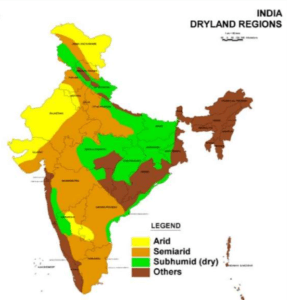In this Blog, you will read about Rainfed Farming and Dryland Farming for all Competitive exams related to Agriculture.
Rainfed Agriculture and Dryland Agriculture
Introduction Rainfed Farming
- Rainfed Agriculture or Rainfed Farming refers to an area that is dependent on monsoon rainfall. All the crop cultivation practices are based on Rainfall.
- Rainfed Agriculture or Farming is Practiced under various conditions such as Soil type, Rainfall Intensity, and Agro-climatic Zones.
- Rainfed Agriculture and its area can be divided into two parts, the Area receiving rainfall less than 750 mm and the area that receives more than 750 mm of rainfall over the year.
Definition:
“Rainfed Agriculture and Rainfed Farming deal with the production of crops where the availability of water is more than 1150 mm or that region is receiving rainfall of more than 1150 mm is called Rainfed Farming or Rainfed Agriculture.”
Introduction Dryland Farming
Dryland Agriculture or Dryland Farming refers to the region in which the kind of farming is practiced in sub-humid to Arid conditions with less water, less irrigation, and Total dependency on Rainfall.
Dryland Agriculture reflects the cropping pattern and crop types based on water availability.
Definition:
“Dryland Agriculture and Darland Famring refers to the region which receives more than 750 mm of Monsoon Rainfall and production of crops depends on Monsoon Rainfall only.”
Types of Rainfed Farming and Dryland Farming
There are major 3 types of Dryland Agriculture which are listed below:
Types of Rainfed Farming and Dryland Farming | ||
Dry Farming | Dryland Farming | Rainfed Farming |
<750 mm Rainfall per Year | >750 mm Rainfall per Year | >1150 mm Rainfall per Year |
Difference between Rainfed Farming and Dryland Farming
What is the major difference between Rainfed Farming and Dryland Farming below listed table is contains proper information:
Difference between Rainfed Farming and Dryland Farming | ||
Properties | Rainfed Farming | Dryland Farming |
Rainfall | Rainfed Farming is the production of crops in the region which receives more than >1150 mm Rainfall per year. | Dryland Farming is the production of crops in the region which receives less than < 750 mm Rainfall per year. |
Regions | Humid and Sub-Humid Regions | Arid and Semi-Arid Regions |
Irrigation | No irrigation with Sufficient Rainfall | No irrigation with insufficient Rainfall |
| Cropping Pattern | Double Cropping or Multiple Cropping | Single Cropping, Mono Cropping, Intercropping |
Regions of Rainfed Farming and Dryland Farming
Region-wise crops to be grown in Dryland Agriculture are mentioned below students can refer to the table for more information.
Regions of Rainfed Farming and Dryland Farming (Crops Grown) | |
Regions | Crops |
Eastern India | Coarse Cereals |
Western U.P. | Coarse Cereals |
| Vindhya Region | Coarse Cereals, Pulses Crop |
South India | Bajra, Groundnut |
| Deccan Plateau | Cotton, Oilseed |
Zones of Rainfed Farming and Dryland Farming | |
Zone 1 | Arid Zone |
Zone 2 | Semi-arid or Temperate Zone |
| Zone 3 | Semi-arid or Tropical Zone |
| Zone 4 | Humid and Sub-humid Zone |

Practices to Improve Rainfed Farming and Dryland Farming
Rainfed Farming and Dryland Farming areas significantly contribute to pulses, oilseeds, coarse grain crops, and cotton. Minimal use of dryland technologies for agricultural production can help fulfill the demand for pulses and oilseed production and improve the economic conditions of farmers. There are various practices to improve the productivity of Rainfed Farming and Dryland Farming are mentioned below:
- Water-harvesting in Rainfed Farming and Dryland Farming: Harvesting of Rain Water where it falls or collects the runoff water in your catchment area. And taking precautions to keep that water clean by not allowing polluting agents into the catchment area. Water harvesting can be undertaken in various ways.
- Collection of runoff water from rooftops.
- Collection of runoff water from local catchments.
- Collection of seasonal flood waters from local streams.
- Conservation of water with the help of watershed management practices.
- Agronomical Activities in Rainfed Farming and Dryland Farming: Crop rotation, Intercropping, Mulching, Drip Irrigation, Less Soil Preparation unless it is not required, Zero Tillage, etc.
- Organic farming in Rainfed Farming and Dryland Farming: Organic farming is a practice that does not allow the use of synthetic agriculture inputs like pesticides, fertilizers, growth hormones, etc., and relies on techniques like crop rotation, farm manure, and crop waste for nutrient utilization.
- Watershed management in Rainfed Farming and Dryland Farming: Watershed management is a very effective conservation measure for the conservation of soil and water resources. It involves the management of land surface and water storage to conserve the soil and water for immediate and long-term use of soil and water for the farmers. Various practices adopted under Rainfed Farming and Dryland Farming:
- Vegetative barriers
- Contour Bunding
- Bunding
- Furrow/Ridges
- Terrace Formation across the slope.
- Irrigation with the help of drip and sprinkler methods.
- Plantation of horticultural species crops.
- Use of Draught Tolerance Crops in Rainfed Farming and Dryland Farming: The use of Draught Tolerance Crops reduces the irrigation for the crop because those crops are modified according to the draught and its tolerability. use of HYV helps to reduce the water demand in crops in Rainfed Farming and Dryland Farming.

